Animals found in the Fallout series.
Animals
- Artistic License – Biology:
- In Fallout, radiation basically acts like magic half the time, often twisting animals into bizarre mutants with very little basis in reality instead of inflicting upon them horrific birth defects and debilitating diseases like cancer (and even then that's only without killing them outright). Justified as Fallout is set in a Retro Universe primarily inspired by pulpy 1950s-era understandings of science. Additionally other factors are at play, like the FEV that was accidentally released during the Great War.
- The various giant arthropods (radscorpions, radroaches, giant mantises, cazadores, etc...) would suffocate to death in real life, due to their breathing systems being much more simplistic than the ones of mammals or reptiles (they essentially absorb oxygen through their exoskeleton). In the distant past of the Earth oxygen concentration in the atmosphere was higher, resulting in much larger arthropods.
- Big Creepy-Crawlies: Most insects adapted to the harsh conditions by growing to huge sizes with an even bigger predatory instinct. They can be as small as a cat like the Radroach, sport wingspans as large as humans like the Cazador, or develop to the size of a car like Honey Beasts.
- Bioweapon Beast: Outside of the regular Nuclear Mutants, a significant portion of the wastelands' creatures were originally engineered by the pre-War government and corporations as some kind of bioweapon that escaped and went feral after the nuclear apocalypse. Some, like deathclaws, cazadores and nightstalkers, were created to be frontline soldiers or ultimate security animals; others, like mole rats, were intended to be released behind enemy lines to be damaging, obstinate super-vermin.
- Boring, but Practical: As evidenced when comparing the beastiary seen in Fallout: 76 (and to a lesser extent, Fallout 1) to the rest of the series, mutant animals from the early days of wasteland tended to have fairly grotesque appearances and abilities, but they were eventually outcompeted by other mutants due to their less functional bodies. The majority of the modern mutant animals, by contrast, are simply enlarged or partially altered versions of their unmutated ancestors.
- Depending on the Writer: The exact reason for the various mutations vary from game to game. Some simply say it's a result of the radiation from the bombs and leave it at that, but other games imply that the mutations are actually the result of tainted FEV that was released into the atmosphere during the war.
- Dying Race: According to Word of God, many of the earlier mutants in the series (and in particular, mostly those found in Appalachia) are eventually driven to extinction due to being out-competed by other animals. Natural selection didn't just end with the Great War, after all.
- Everything Trying to Kill You: By default, thanks to the current state of the United States. Taking the Animal Friend perk can take a lot of the pressure off of this though, even taming the relentless yao guai into letting you be, or even coming to your aid if you get in a fight.
- Finishing Move: In 4, many animals now have special animations where they'll execute a critically injured human to deal the finishing blow in a dramatic way.
- From Nobody to Nightmare: A few of the more exceptionally terrifying and dangerous Wasteland critters were originally very innocuous and downright harmless animals before radiation and/or pre-War biochemical engineering changed them into the monsters that plague the Wasteland today. Probably the most stark examples are the deathclaws (originally Jackson's chameleons), fog crawlers (originally mantis shrimp and/or crayfish), and scorchbeasts (originally bats).
- Law of Chromatic Superiority: Post-4, the strongest ranks of enemies are marked by color — albino variants are invariably deadlier and tougher than regular types, while the green-glowing radioactive ones are stronger still.
- More Predators Than Prey: A side glance at this page can give this implication, especially when the vast majority of North America was turned into a radioactive wasteland by the Great War. As with the majority of science in Fallout, it's an Acceptable Break from Reality to allow for a more interesting setting along with playing along with the series' theme of taking place in an After the End Death World.
- Mutants: What virtually all of the animals on this page are, being normal animals altered by generations' worth of exposure to "radiation poisoning" along with potential exposure to the Forced Evolutionary Virus. The exceptions to this are the animals that were specifically genetically engineered by the Pre-War US government to serve as bio-weapons, such as Deathclaws, Mole Rats, Scorchbeasts and Wanamingos (along with, to a lesser extent, Cazadores and Nightstalkers).
- Nature Is Not Nice: Most plant life as we know it seems to have been devastated, which doesn't leave much room for passive herbivores in some parts of the Wasteland. As a result, a trek out into the wilderness can lead to someone inevitably having to fight off opportunistic wildlife, almost all of whom definitely see humans as viable prey worth hunting for.
- Non-Malicious Monster: Rarely can you call these creatures evil, as they're just animals trying to survive in the new ecosystem.
- Nuclear Mutant: Whether due to the fallout from nuclear bombs irradiating species to terrible new evolutions, the U.S government and scientists meddling with wildlife to create ideal attack animals, or one factor exacerbating the effects of the other, the wildlife has grown and mutated to better suit the Death World that is the Fallout universe. It doesn't get much better for humans; the man-made FEV mutations created the Super Mutants who are dangerously huge and aggressive (and usually dumb) hulks of former humans. Meanwhile, ghoulification can be the fate of any human who gets lethally irradiated yet doesn't die, becoming a walking and immortal corpse of a human-being who may be doomed to eventually lose their minds and go feral.
- Super-Persistent Predator: Due to gameplay mechanics, hostile animals seen in this series will chase after prey, even humans, with all they've got once they've spotted them. Then again, it's a nuclear wasteland and food is hard to come around; it's possible the animals are just that desperate.
- To Serve Man: With how dire the circumstances can get in the Wasteland, animals and even former humans like Super Mutants will gladly put humans on the menu. Walking through an animal's den or a building reclaimed by nature will inevitably reveal stashed away human corpses for later feasting, or just the gored and skeletal remains of past human prey left behind by whatever ate them.

Found in the shallow marshes of Far Harbor, Anglers are creatures who submerge and camouflage themselves in the water, using their lures to blend in with the local lure weed fauna. When prey walks near, they'll jump from their hiding spot and rush to attack with sharp claws and teeth.
- Ambushing Enemy: Anglers hide themselves within patches of aquatic plants, waiting to jump out and attack anyone passing close to their hiding spots.
- Fish People: They have developed humanoid bodies in addition to their much larger sizes, with long arms and bowed legs, but otherwise retain the scales, fins and heads of their fully piscine ancestors.
- Luring in Prey: They have lures on their heads that resemble the plant lure weed (which is useful to the player since its an ingredient needed to cook wolf meat into wolf ribs), and they like to hide in shallow water beneath patches of lure weed with their own lure above the water, springing up in ambush if the player approaches to harvest the weed.
- Spotting the Thread: Their lure camouflage is effective and Far Harbor is usually a dark and murky environment, but they lack the leaves at the base of their lure unlike actual lure weeds, letting you pick them out if you're out picking plants. Or you can just use VATS to scan the waters for any anglers waiting below like pseudo-X-Ray Vision.
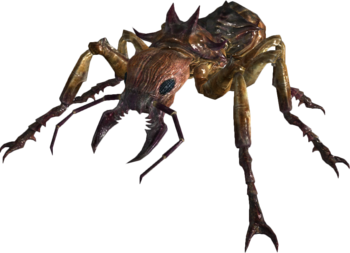
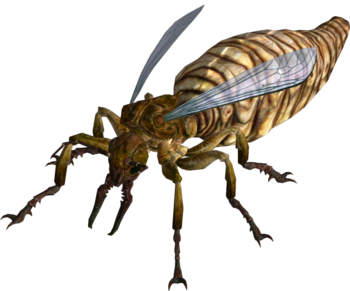
Giant ants, sometimes referred to as radants instead, are mutated descendants of the common carpenter ant. They have grown considerably in size, but otherwise remain much the same as their forebears, living in large colonies and responding aggressively to intrusions. A variant known as fire ants exists in some areas of the former States, which can spit fire.
- Achilles' Heel: Their antennae are highly sensitive, and striking them will send them into uncontrollable frenzies.
- Action Bomb: The ants in the Nellis Air Force Base outside Vegas have eaten the supplies of gunpowder, meaning that shooting them can cause them to explode violently like a bomb. This isn't a good thing for the player either, because there's also plenty of armed artillery shells that'll blow them to ribbons if the ants explode in a bad spot.
- Ant Assault: Giant, aggressive ants capable of posing a serious threat to people. They're mostly just animals in the wilderness, but in at least one case serve as a villain's minions.
- Big Creepy-Crawlies: While on the small side for Fallout arthropods, they're still in the same size range as dogs. Queens can get to be a lot bigger than that, usually taking up a significant portion, if not half of, the cavern they live in.
- Color-Coded Elements: Fire ants are distinguished from the regular kind by being red instead of brown.
- Gone Horribly Wrong: While giant ants are "only" a regular side-effect of all the radition, the fire ants were created as a result of a direct attempt to breed giant ants to be smaller and less dangerous that went completely pear-shaped.
- The Goomba: They're generally fairly weak enemies, and alone only pose a threat to the lowest-levelled players.
- Hive Caste System: In addition to the queens, the player will usually run into two different types of ant, the workers and the larger, stronger soldiers.
- Hive Queen: As with real-life ants, their colonies are centered around immense ant queens that produce their eggs. Unlike real ant queens, these are also fairly powerful — if immobile — creatures capable of tanking out a good deal of damage and dealing back their own.
- My Species Doth Protest Too Much: The Lone Wanderer can encounter a colony of small (relatively speaking, as they're the size of dogs) peaceful ants who are being menaced by a colony of large aggressive ants.
- Pun-Based Creature: Fire ants can literally spit fire (or, at least, flammable liquid).
- Super Spit: Giant ant queens can usually spit acid. Fire ants have developed a flammable secretion from their former acid glands that they ignite by clicking their mandibles, essentially spitting fire.
- Zerg Rush: To make up for their individual weakness, giant ants usually swarm larger enemies in groups to disorient and overwhelm them.
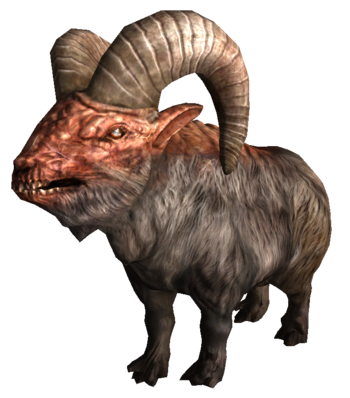
Mutated from native bighorn sheep populations, Bighorners are a fair sight larger than their smaller relatives and are incredibly territorial out in the wild, but humans have managed to domesticate plenty of their numbers much like Brahmin. Outside of farms in humble settlements, Bighorners can be found in large herds with adults guarding their young while hanging around banana yucca fruit.
- Gentle Giant: Domesticated Bighorners are absurdly huge next to a human, but are perfectly docile so as long as you don't hit them. Less pronounced for wild Bighorners who're likely to run you down for getting too close to the herd, but they're certainly more fair with their aggression than most other wasteland predators.
- Glass Cannon: For all their aggression and imposing size, their big bulky heads make for easy headshots, a sufficiently leveled Courier with good aim and firearm can spray a herd of them down.
- Herbivores Are Friendly: Played with, they probably won't attack you on sight like a mole rat, yao guai or gecko would, but that doesn't mean you should approach a wild animal with their family in tow.
- Mama Bear / Papa Wolf: The main reason why they'll attack you for getting close in the wild, they really care about their offspring and will charge to protect them.
- No-Sell: According to Easy Pete the Bighorners are extremely stubborn creatures and if you try to put a pack on one of them (like you would a brahmin), they will simply lie down until you take it off.
- Piñata Enemy: For the size of their herds, big heads to target, fair amount of experience per adult slain and meat with a good amount of healing potential that can be dropped in large amounts, a herd of Bighorners is a productive target to hunt for.
- Zerg Rush: Anger a herd of Bighorners unprepared and you'll be backpedaling far away from them.

Originally once the small yet aggressive horsefly, the Great War caused these pests to mutate to gigantic sizes and grew their aggression out twicefold. When spotting prey, they'll bob and weave around them while firing their weaponized larvae to stab into the target.
- Big Creepy-Crawlies: They're big, fat and ugly horse flies who're after you.
- Boss Battle: In the Old World Blues DLC for New Vegas, you can fight the Legendary Bloatfly. Unlike regular Bloatflies which you'd usually blow away instantly, the Legendary Bloatfly is one of the toughest animals in the game and can easily massacre the player if they get cocky. To put it into perspective how deadly it is, if you were to spawn it in and have fight other enemies, like the Legendary Deathclaw, it'll usually curbstomp them quickly.
- Defeat Equals Explosion:
- In Fallout 4, they'll sometimes pop into little bits of insect gore and goo when killed.
- The Legendary Bloatfly will explode like a plasma bomb when killed.
- The Goomba: Most Bloatflies go down easily to just about anything you can dish out. Unlike Radroaches though, another pathetically weak mutant insect, they got the speed, small size and attack range to give a fresh player a bit more of a fight.
- Weaponized Offspring: Those projectiles they fire? That's their larvae.
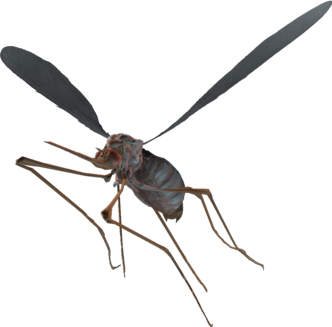
Before the Great War, mosquitoes were some of the most common and reviled bloodsucking pests dealt with on the planet. Their mutations after the War made them more than capable of draining a person of more than just a drop of blood.
- Achilles' Heel: While not a weapon per se, wearing Powered Armor makes some of their most dangerous attacks harmless and cripples their offensiveness.
- Big Creepy-Crawlies: They're huge mosquitoes a little larger than a human adult's torso.
- Blood Sucking: Naturally, being mosquitos, they're fond of doing this. You might see a couple of Bloodbugs sitting over the corpse of a slain Brahmin who's obviously been sucked dry by the bugs. And to your detriment, they can do this to you by entering an animation in which they clamp themselves onto your body and jab their proboscis into your chest for a big gulp of blood.
- Elite Mooks: The Red Widow and Infected variants, which can deal dismayingly large amounts of poison damage along with being faster and having more health than normal bloodbugs.
- Impaled with Extreme Prejudice: They can drive their sturdy and needle-like proboscis right through a person's chest.
- Mosquito Miscreants: Take a mosquito, mutate it to the size of a man and irradiate it enough that a bite from one can induce radiation poisoning and you'll get the Bloodbugs.
- Super Spit: After drinking your blood, they may decide to return it back to you by spraying it at your face to deal damage.

Originally a species of tiny and aquatic parasitic worms, radiation has mutated the humble bloodworm to the size of a man. Furthermore, they now dig through soil with ease and devour anything in their path, most notably infesting the Dry Rock Gulch theme park at Nuka-World in western Massachusetts.
- Dig Attack: Their main ability is to rapidly tunnel underground and pop up where they please, making them especially difficult to keep track of.
- Expy: Of the Graboids from the Tremors franchise. Both are large subterranean and carnivorous worms that devour anything in their path, and the bloodworms being encountered in a pseudo-Western old ghost town mirrors Tremors taking place in an out-of-the way town in the American southwest.
- Fake Ultimate Mook: In the lore, the bloodworms were deadly enough to wipe out all settlers who tried to hide in Dry Rock Gulch after the Raiders moved in, and were also seen as dangerous enough to make the Raiders hesitate on just taking the Gulch for themselves. In gameplay, bloodworms are remarkably fragile and go down in a few hits, and are only really threatening if encountered in a group.
- Fragile Speedster: They're incredibly fast and like to leap right out of the ground directly at you, but they can be killed with most weapons in three or so hits.
- Lamprey Mouth: Have four interlocking jaws laden with sharp teeth that they use to help tunnel through earth and soil.
- Misplaced Wildlife: Practically turned up to eleven, as real-world bloodworms are aquatic creatures found in shallow seas while these bloodworms have mutated into being terrestrial organisms that live in the desert.
- Sand Worm: Human-sized mutated worms that burrow underground at a frightening clip, bursting onto the surface to attack and devour prey passing above.
- Wormsign: When they're tunneling around in a fight, their movement is marked by a faint outline of their tunnel. Furthermore, when they're tunneling, the surface ground is obscured by clouds of dirt that makes it harder to spot them unless V.A.T.S. is equipped.
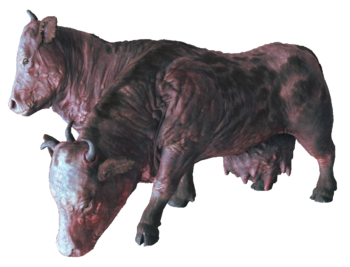
Brahmin are mutated cows who, since the Great War, have developed an assortment of strange and dramatic mutations across their bodies, most obviously their second living head. Despite this, they're still prized and used as livestock across the Wasteland.
- Cattle Baron: Brahmin barons hold huge influence in the civilized parts of the wasteland, with their job to raise brahmin for food being vital for the economic security of the NCR in particular. Mess with their brahmin, and you'll likely hear the NCR come knocking to investigate.
- Mechanical Lifeforms: In 4, you may find that in addition to humanoid synth spies infiltrating your settlements, synth brahmin can arrive incognito.
- Mutants: Almost everything's a mutant in the Fallout universe at this point, but Brahmin deserve special mention: they sport two heads, multiple horns, and huge and mutated udders bristling with teats, are totally hairless, are said to have eight stomachs and brahmin bulls are said to have four testicles. Humorously, mutant brahmin are occasionally born to regular herds... with only one head.
- Mundane Utility: Brahmin are this incarnate compared to most other mutant animals. They're easy to domesticate, provide vital resources when raised in groups, and traveling caravans frequently use them to hold their wares while they travel, strapping containers all around their body full of gear.
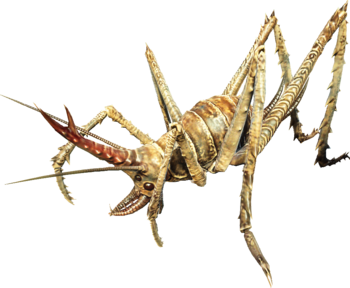
Mutated descendants of common insects native to caves, mines, basements and assorted dark and enclosed spaces throughout America. The ones seen in Nuka World seem to have shed their troglodytic habits, being mostly found on the plains around the park; the Appalachian ones can also be found roaming in the open, but are still common sights in the mountains' caves and abandoned mines.
- Ascended to Carnivorism: Real-life cave crickets are detritovores who mostly feed on scraps of plant and fungal material and skin flakes from bigger creatures. The Fallout kind are aggressive predators.
- Big Creepy-Crawlies: Common cave crickets — normally no larger than a fingernail — grown to around the same mass as a human man.
- Horn Attack: Besides size, the main thing distinguishing them from their pre-War ancestors is the sharply pointed chitinous growth on their foreheads, which they use to impale potential prey.
- Law of Chromatic Superiority: Their basic kinds are arranged in increasing strength and marked outwardly by color — basic tan crickets, black hunters and brightly colored piercers.
- Monstrous Cannibalism: They're reported to be cannibalistic, or at least to consume each other's eggs.
- Pint-Sized Powerhouse: Their elite variants can take a decent beating for an insect and give a deadly stab with their horns, evolving to be supersized aside. This is especially apparently in Fallout 76 where it's entirely possible to run into a cave cricket a significantly higher level than you in the early levels, who'll shrug off most of the bullets you're spewing at it while it's hopping mad.

As a result of careless animal experimentation on Tarantula Hawk Wasps and even worse attention to security, swarms of Cazadores have established themselves as deadly predators in the Mojave Wasteland. Tough, fast and fond of dealing a fatal dose of venom, they're bound to make even seasoned Wastelanders wary of passing their nests.
- Achilles' Heel:
- Like deathclaws, their biggest advantage is their speed. Cripple their wings to make fighting them way easier and slow them down to a crawl.
- Like some other insects, they can be shot in the antennae, which will frenzy them and make them attack everything.
- Beef Gate: They serve as one alongside the deathclaws in Quarry Junction in New Vegas. After coming fresh out of the Goodsprings clinic, you can either go straight ahead into town like you're expected to, or veer to the left towards the canyons. Going left can eventually introduce you to a swarm of Cazadors who'll obliterate the freshly revived Courier, assuming you can't sneak past them. Otherwise, you're better off going through the better balanced Goodsprings instead.
- Big Creepy-Crawlies: These bugs have wingspans that exceed the size of a human adult.
- Bioweapon Beast: They were artificially created by Dr. Borous, one of the researchers at the Big MT scientific facility, largely for the hell of it; supposedly, their purpose was to serve as security animals. They were also supposed to be sterile, but naturally enough they weren't and spread like wildfire after the nuclear war.
- Damage Over Time: The bulk of Cazador damage comes from their venom after the sting. On the other hand, it acts so quickly and drains so much HP that it can easily overwhelm unprepared players in less than a minute. Add to the fact that Cazadors love to gang up on prey and sting from multiple angles and you might not even escape them in time to actually die from the venom. Bring plenty of antivenom if you want to nullify this instantly.
- The Dreaded: While not mentioned often in dialogue, no one takes Cazadores lightly. Most notably, their danger is only below deathclaws in Red Lucy's egg hunt, and the Courier's Brain hates fighting them, implying that going against them is stressful for the character no matter how skilled they get.
- Fragile Speedster: They're fast and hard to hit, but they have zero protection.
- For Science!: Their very existence, as well as their sheer numbers are primarily attributed to Dr. Borous performing genetic experiments on tarantula hawks simply because he could before this particular experiment evolved into an actual obsession of his.
- Glass Cannon: While they have relatively good HP, are very fast and deal huge damage, they have zero damage threshold, so shotguns or hollow-point bullets will just tear them apart.
- Red Eyes, Take Warning: They're high up on the list of dangerous Wasteland creatures and got the red eyes to prove it.
- Somewhere, an Entomologist Is Crying: The game features "young Cazadores" that are smaller than adult ones. In real life the Tarantula Hawk Wasp goes directly from Pupae to the adult stage after it finishes devouring the insides of the (still-living tarantula) it hatched in. Possibly justified by whatever genetic tinkering was done to them by Doctor Borous.
- Wicked Wasps: They are giant Tarantula Hawks who are almost as deadly as Deathclaws.

Centaurs are the FEV mutated abominations raised to help support their super mutant handlers. Their biology tends to be unpredictable due to the process of creating them, since they're generally spliced between multiple species, most notably humans and dogs. They typically serve as watch and guard dogs for their mutant masters, lashing at intruders and alerting the others of the incoming threat.
- Admiring the Abomination: Super Mutants seem to think of centaurs like how we'd think of a loyal dog, caring for them like pets. Tabitha of Black Mountain is positively in love with centaurs, gushing over how adorable pets they make.
- Art Evolution: In the Black Isle games, centaurs sport two heads, one of a dog and another with a human torso and head and plenty of hand-feet dragging them along. In the Bethesda-made 3 and New Vegas, they've lost the dog head and only slither around with a thick and diseased human torso, now sporting some horns and a long tongue. In the unused concept for ''4'', they've degenerated into a multi-eyed and limbed quadrupedal creature who resembles no single creature directly, with blood-red skin on top of it all.

- Body Horror: Centaurs are grotesque products of mutation, the result of multiple bodies — often those of entirely different creatures — fused together into shambling, hideous things of malformed flesh and exposed bone.
- Fluffy the Terrible: Near the base of Black Mountain in New Vegas, there's a huge and irradiated centaur that's even further mutated that others of its kind, and is seemingly responsible for killing a Brotherhood patrol as he's guarding the bodies. And his name is Moe.
- Mix-and-Match Critters: Literally. Centaurs are what you get when multiple creatures are thrown into a pit of FEV and left to fuse together as they mutate. In early games, human and canine traits are both clearly visible in the resulting centaurs.
- Multiple Head Case: In 1 and 2 only, with one dog head and a human head sharing the same body. The heads don't seem to get along, with the dog head trying to nip the human half.
- Our Centaurs Are Different: In this case, "centaur" refers to a mutated amalgam of creatures, including humans, with a roughly centaurine stance.
- Overly-Long Tongue: In 3 and New Vegas, they sport a really long and conjoined tongue that they'll whip enemies with.
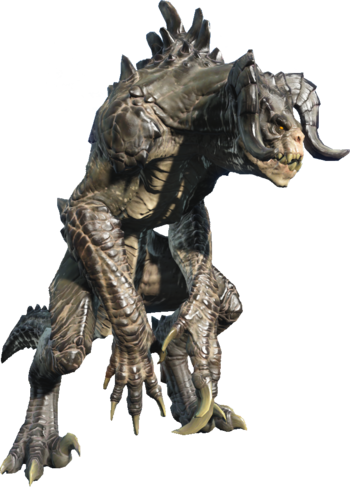
Once, these creatures were Jackson's chameleons, but secret experimentation and genetic engineering by the US government to create biological weapons mutated them into monsters. The Master later experimented on deathclaws to refine their powers further, and they escaped captivity and spread across the continent. Towering over humans with claws as long as your arm and jaws large enough to bite that arm off, deathclaws are some of the most powerful creatures you'll ever have the misfortune to come across. The Enclave occasionally tries to make use of deathclaws as shock troopers.
- Achilles' Heel:
- In the Bethesda-era games, they are very vulnerable to crippled legs, which not only stops them from using their leaping attacks, but drastically slows their walking speed. With one of their legs crippled even the mightiest of deathclaws can only hobble towards you slowly while you wheel back and take potshots at it from a safe distance.
- Beginning with Fallout 4, deathclaws have a softer underbelly where they take more damage.
- The classic Black Isle-era Deathclaws, on the other hand, are vulnerable to eye shots. That is if you can manage the shot.
- Always Chaotic Evil: Actually averted; deathclaws are very aggressive naturally, but some are willing to be friendly to humans if said human helps it, such as when the Sole Survivor returns an unhatched Deathclaw egg to its mother in 4; the mother will refuse to attack unless you take the egg back or attack her.
- Art Evolution: The depiction of Deathclaws has evolved a fair bit over the course of the games. In the original two, they were long-armed, apelike knuckle-walkers, further shown in the first game’s manual with backward-facing horns and pointed muzzles. The 3D games introduced their more familiar look, making them bipeds with a human-like (if still long-armed) stance, a row of spines down their back, and a very slender build, with long wiry limbs and thin, pointy horns and claws. In 4, they were made much bulkier, with more heavily muscled limbs and torsos, thicker and blunter horns, and a more hunched over posture.
- Attack Its Weak Point: In 4, they have a soft, unarmored spot on their belly. It's hard to hit them there, though, considering that they can actually move around and dodge bullets with ease.
- Badass Pacifist: The intelligent deathclaws from Fallout 2 have very strong morals and only kill to hunt animals or protect themselves and the humans they shelter in Vault 13.
- Beef Gate: They serve as one in New Vegas. Your main quest has you trying reach the titular New Vegas city, and it seems like the straightest and shortest road to it is through Quarry Junction. Unfortunately, a huge pack of deathclaws are nested across the whole area and walking through as a freshly made character will probably get you killed. You can either try your luck in sneaking across undetected, or go the route the main story intends you to follow through all the little towns along the way.
- Bioweapon Beast: Originally created from a mix of various organism (one of which is a chameleon) by the pre-War government to serve as super soldiers.
- Brainwashed and Crazy: Not that they were any more peaceful before, but in Fallout 3, the Enclave could be found having installed a mind control device on a Deathclaw's head to use them as attack animals on anything that isn't them. Disable this device to free them from their control, and the Deathclaw'll promptly turn on their controllers if they're nearby, likely killing most of them for you.
- Car Fu: Starting in 4, the stronger deathclaws now have a special attack consisting of them literally hurling entire wrecked cars at people, killing them instantly.
- Depending on the Writer: In the West Coast games, deathclaws are more communal animals, often being found in large packs of at least a dozen different creatures led by a matriarch. In the East Coast games, deathclaws seem to be more solitary animals (the Deathclaw Sanctuary and Old Olney in the Capital Wasteland both excepted), often being found in small groups of three (two parents and a child) and are mentioned as being highly territorial of one another. 4 even has a random encounter where two male deathclaws can be found engaged in a vicious Duel to the Death over their territories.
- The Dreaded: Everyone in the Fallout universe is rightfully afraid of deathclaws. It's right there in the name even.
- Defector from Decadence: The intelligent Deathclaws created by the Enclave are thoroughly disgusted by their actions and go rogue.
- Elite Mooks: Deathclaws are universally among the toughest enemies you'll face in any given Fallout game. Even more dangerous variants sometimes appear: there are Deathclaw Mothers in some games, New Vegas introduces the Deathclaw Alpha Male, and Fallout 4 has the Glowing, Chameleon and Albino Deathclaws.
- Finishing Move: In 4, they have several attacks used to finish off human foes.
- One has them grab the Sole Survivor and lift them up in the air. If they have high health or is wearing Powered Armor, the deathclaw just roar in their face and throw them. If the Sole Survivor would die from the next attack, it'll brandish its other claw menacingly for a moment before gutting them with a claw swipe.
- Another one takes place where the deathclaw uses its claw to skewer the unfortunate victim and chuck them very high in the air behind them, like throwing away a wad of paper.
- Their last one has them grabbing a human by the legs, whip them around in the air and slam their body right against the ground torso-first to splatter them.
- From Nobody to Nightmare: Would you believe that these walking, ten-foot tall Cuisinarts that can tank an Anti-Material Rifle slug or a mini-nuke to the face like it's a light breeze started their existence as the Jackson's Chameleon?
- Giant Space Flea from Nowhere: In Fallout 4, during the quest "When Freedom Calls", the player is tasked to eliminate Raiders from Concord. After beating them and their leader, a huge deathclaw appears from nowhere and attacks the player, serving as the "boss" of the area. There's very little and vague foreshadowing about it (with Mama Murphy saying that "There's something comin'. And it is... angry" and Preston saying that there's "something else outside"). Justified with it being implied to have been attracted to the scene by the sound of gunfire.
- Hollywood Chameleons: The Chameleon Deathclaw in Fallout 4 can use stealth like a Stealth Boy and turn invisible (with the exception of an Invisibility Flicker), harkening back to their evolution from Jackson's Chameleons.
- Homage: According to Scott Campbell (formerly of Interplay and who worked on both 1 and 2), their design was modelled to some extent after the Tarasque from Dungeons & Dragons.
- It Can Think: The Deathclaws are vicious, brutal predators, but they are capable of reasoning. 4 features a Deathclaw mother that will not attack you on sight, instead letting you put its egg back in its nest.
- The Juggernaut: They used to be chameleons, but now they're just hulking masses of muscle and claws that can rip apart damn near anything in their path.
- Lightning Bruiser: They move fast, hit hard, and take a lot of punishment.
- Mama Bear: A Deathclaw pack will have a "matriarch", or alpha female, who lays the eggs and cares for the baby Deathclaws. They are extremely protective of their packs. Fallout 1, 2, New Vegas and 4 feature at least one with her eggs and offspring in a quest.
- Natural Weapon: Their claws are long and sharp enough to slice anyone into ribbons. Only people in suits of Power Armor can hold up to their onslaught, and even then it's implied to not be for too long.
- Names to Run Away from Really Fast: Does the name "Deathclaw" sound tame to you?
- Non-Malicious Monster: They're extremely dangerous, and feared for a reason, but they're ultimately just apex predators who hunt and kill to survive.
- Roar Before Beating: In 4, they do a Mighty Roar when engaging combat. This can actually work against them, as they expose their soft belly when doing so.
- Stealth Expert: The Chameleon Deathclaw introduced in 4 harkens back to their evolutionary roots, giving them the power of natural camouflage.
- Super-Soldier: They were originally created by the U.S. government to replace human troops in battle, and were later refined by the Master for similar purposes, resulting in ten-foot beasts capable of tearing a human apart and shrugging off small arms fire, traits that, since they weren't sterile like Super Mutants, allowed them to spread across North America like wildfire and become one of the most dangerous things in the wastelands. Later on, the Enclave repeatedly tried to tame them to use as shock troops.
- Super-Strength: They can tear through Power Armor like tin cans, and can easily squish people into pulps (also while still in Power Armor) by just subjecting them to enough blunt force trauma.
- Super-Toughness: Their skin by default has a damage threshold on par with standard Combat Armor (at least in 1, 2, and New Vegas; 3, 4, and 76 don't have the DT mechanic). This means everything at 5.56x45mm ball level or below just bounces off their skin, bar shots to weak spots like the eyes. Better break out the anti-materiel rifle or some AP rounds.
- Underground Monkey: Several varieties of Deathclaws have showed up in the games, mostly the later ones.
- Fallout: New Vegas introduced Mothers, who have blue skin and swept-back horns, and Alpha Males, who have dark skin and elongated horns. Both are notably taller, faster, and stronger than the vanilla Deathclaws.
- Fallout 4 added Glowing Deathclaws, which glow green and deal radiation damage, Albino Deathclaws with very high health, and Chameleon Deathclaws which can change color and blend into their background.
- 4's Nuka-World add-on added Quantum Deathclaws, which were apparently mutated by the park's river of Nuka-Cola Quantum and glow blue-purple, and Gatorclaws, essentially Deathclaw-shaped alligators created from splicing gator and Deathclaw DNA.
- Talking Animal: The Enclave experimented with intelligent Deathclaws in Fallout 2. While most of them weren't more intelligent than a 5-year old kid, some were able to develop above-average intelligence compared to a human and were capable of speech. They were tragically wiped out by the Enclave, and the option to save them was
 Dummied Out.
Dummied Out. - Uplifted Animal: As noted above, in Fallout 2 a group of deathclaws were uplifted to human-level sapience by Enclave experiments. Unfortuntely, only Goris is known to have survived the Enclave's later genocide of their people.
- The Worf Effect: Deathclaws are one of the most dangerous things you'll encounter in the Wasteland, so the series occasionally demonstrates just how badass something is by having them kill a Deathclaw. Frank Horrigan punches one into pieces in Fallout 2, and the New Vegas expansion Lonesome Road has a Tunneler tear a Deathclaw's head off. In Fallout 4, one of the first things you do is get into a suit of Power Armor, grab a minigun and fight a Deathclaw (though it's still a very challenging fight).
Gatorclaws

These genetically modified alligators were created by the late Dr. Darren McDermot centuries after the nuclear exchange, who cloned the gatorclaws as a means to protect himself, the Safari Adventure attraction in Nuka World, and most importantly the Nuka-Gen Replicator, a machine capable of cloning tissue samples and entire creatures. Killed by his own creations, gatorclaws now wander near Safari Adventure with the replicator still active and pumping out more over time.
- Bioweapon Beast: Like the deathclaws, they're created as vicious attack animals descended from an unmutated species. Where deathclaws came from the Jacksons chameleon, gatorclaws come from alligators.
- Gone Horribly Right: Dr. McDermot cloned creatures capable of defending the replicator from getting into the wrong hands alright, but not only did he die before he could shut it off, the machine is also replicating a constant supply of the beasts. His last words before he died of his injuries was a plea for anyone to stop the machine, but the gatorclaw presence has made that practically impossible.
- Never Smile at a Crocodile: Or a genetically modified alligator that dwarfs most living things it comes across. In any case, they're just as vicious and nimble as their deathclaw counterparts.
- Palette Swap: Minus their flatter, longer and hornless heads and their shorter claws, gatorclaws are functionally the same as deathclaws encountered normally. They share most of the same animations, fighting styles, they're about the same size and they've got the same weaknesses. The main difference is that gatorclaws can't grab and throw people.
- Respawning Enemies: Notably averted, unlike other enemies. Gatorclaws will not respawn once the replicator is dealt with, so killing them down to the last specimen will rid Nuka World of their presence.
- Unique Enemy: There's only one albino gatorclaw encountered, the rest are of the normal variety.
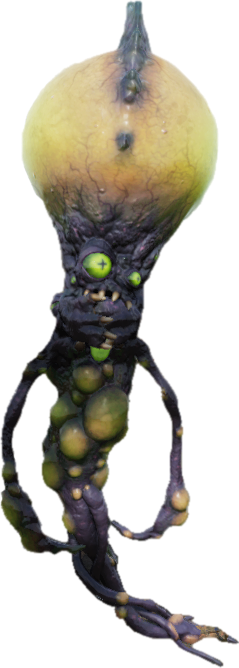
Flatworms mutated by exposure to intense radiation and FEV, floaters have become bizarre, grotesque creatures that drift through the air on sacs filled with biologically produced gas.
Two distinct types of floaters exist: the ones seen in California and associated with the Master's forces and the ones found in Appalachia, which look very different from one another.
- Acid Attack: Floater gnashers secrete acidic pus; they cannot launch it like other variants do with theirs, instead coating their bites with it.
- Admiring the Abomination: The Huntersville Super Mutants seem to find their "local flavor" of Floaters to be adorable; they can be found trying to domesticate the animals and will sometimes even go into combat with them at their side.
- Ambushing Enemy: Appalachian floaters hunt by burrowing beneath the ground and jumping out to ambush prey passing above.
- Attack Animal: Several floaters have been domesticated and are used in combat by the Huntersville Super Mutants.
- Color-Coded Elements: In 76, the three floater variants are distinguished chiefly by the color of their eyes and saces — gnashers, which secrete acid, are green; flamers, which throw burning pus, are dark orange; and freezers, which can spray freezing liquid, are light blue.
- Defeat Equals Explosion: In 76, defeated floaters explode in a burst of acidic, burning or freezing-cold pus.
- Exotic Eye Designs: In Fallout 76, each floater variant has its own peculiar pupil shape — gnashers have cross-shaped pupils, flamers vertically rectangular ones, and freezers thin, horizontally rectangular pupils.
- An Ice Person: Floater freezers can spray volleys of freezing-cold fluids, which can severely damage machinery it lands on.
- Lamprey Mouth: The Californian floaters have a large circular mouth on their upper sides, which opens and closes radially and is lined with sharp teeth.
- Living Gasbag: They get their name from the large sacs growing from their bodies, which are filled with noxious, flammable gases that allow them to float in the air. Californian floaters have multiple egglike sacs spouting from their undersides, while Appalachian ones have a single large balloon growing from their heads.
- Multipurpose Tongue: Their tongues are long and very powerful, and serve as their primary weapons.
- Playing with Fire: Floater flamers secrete a highly flammable pus, which they can throw
- You Don't Look Like You: Fallout 76's floaters look almost nothing like the ones from the Black Isle games they were inspired by. They lack the earlier kind's radially-symmetrical mouths, horizontally flattened bodies, eyelessness and multiple small flotation sacs hanging from their undersides, instead having vertically-arranged bodies, roughly humanoid mouths and arm-like tentacles, multiple eyes and a single giant gas sac growing from their heads.
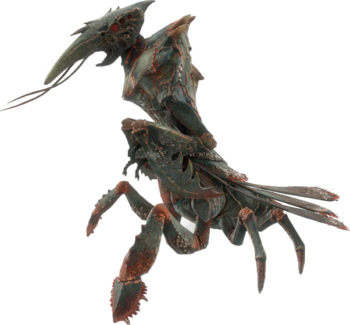
The giant mutated shrimp who lurk the foggy shores of Far Harbor, fog crawlers are irritable and highly territorial predators who respond to anything in their path with an unrelenting charge and claw swipes that can rip men apart, using their tough shells to shrug off gunfire and barrel right over their targets.
- Big Creepy-Crawlies: Mutated crustaceans as tall as a small tree.
- Boss Battle: Shipbreaker is a boss-leveled fog crawler who's established herself as an absurdly deadly and aggressive specimen even by her species' reputation. Old Longfellow tasks the Sole Survivor with tracking her down to end her terror on the island.
- Boss in Mook Clothing: The Enraged Fog Crawlers are the toughest variant, and they can take tons of effort to kill and run over any player who isn't decked out in their best gear.
- From Nobody to Nightmare: Shrimp and crayfish are generally the bottom of the food chain, are usually smaller than your hand and tend to be at the mercy of their predators. This is clearly not the case anymore.
- Lightning Bruiser: Catch their attention and you'll find yourself backpedaling away as the thing gallops towards you, requiring multiple ammo magazines and/or several explosive weapons to put down.
- Mix-and-Match Critters: What exactly the fog crawler evolved from is somewhat of a mystery, with the best two contenders being the crayfish or the mantis shrimp (particularly the "spearers", the ones with long claws for arms and not fists). They share the crayfish's head and upper body and mantis shrimp arms/weapons.
- Nigh-Invulnerable: Due to a programming glitch, Enraged Fog Crawlers have a Damage Resistance of over 4000. To put that into perspective, that mean that they can walk off multiple Fat Man blasts like they're strolling through a summer rain. That damage resistance is more than twice what a fully upgraded set of X-01 power armor has.

Geckos descend from an unknown species of lizard native to the Oregon-California border that was mutated by exposure to environmental FEV contamination. They began to breed extremely quickly once their mutations stabilized and soon spread south into California proper; by the time of New Vegas, they've expanded into the Mojave Wasteland as well.
- Breath Weapon: Fire geckos can breathe fire.
- Color-Coded for Your Convenience: Most geckos types are named after and distinguished by their scale color, including silver, golden and green geckos.
- Crafted from Animals: Gecko hides are valuable and strong, and are often used to create clothing and armor.
- Elite Mook: Fallout 2 has golden geckos, which have higher health and stats than the other kinds and deal radiation damage. In Fallout: New Vegas, they're superseded by green geckos with even higher stats and poisonous spit.
- Law of Chromatic Superiority: In Fallout 2, silver geckos are the weakest and most common kind, while golden geckos are rarer and stronger.
- Shout-Out: Cut content for New Vegas includes a gigantic fire gecko with a super-strong fire breath and with stats high enough to allow it to kill even the strongest creatures in the final game. The game files call it as Gojira.
- Super Spit: Green geckos can spit poisonous saliva.
- Tastes Like Chicken: According to NPCs, properly cooked gecko meat tastes just like canned chicken.

The mutated, giant, and ravenous salamanders found in Far Harbor, Gulpers lurk around marshes and in trees waiting for potential prey. Using their giant maws, they'll swallow almost anything whole without regard for what's edible and what's not. Gulpers grow larger and stronger with age, with the eldest ones being far more deadly than the much more common young gulpers.
- Attack Its Weak Point: Their hides are strong enough to take a good amount of punishment, but their soft underbellies are especially vulnerable to damage.
- Car Fu: Like with deathclaws, the largest gulpers are strong enough to punt wrecked cars, running the player over and instantly killing them.
- Death from Above: Along with waiting around in marshes, gulpers also like to find a tall tree, hang onto a branch with their tails and wait for prey to walk under them for a surprise attack. In gulper habitats, it pays to look up often to shoot them down before they land on you.
- Eyeless Face: They may seem like this at first glance (thanks in large part to their huge mouths and prominent foreheads), but a closer look will show they have a set of tiny, beady black eyes on the far sides of their faces.
- Extreme Omnivore: Gulpers tend to eat first and worry about indigestion later, leaving plenty of inedible objects in their guts that was no doubt left from past meals.
- From Nobody to Nightmare: They went from the tiny, cute and relatively passive salamanders to a terrifying, deadly and gluttonous predator capable of swallowing smaller (human) prey whole.
- Horror Hunger: Gulpers are noted to have an absolutely huge appetite, and examining their bodies after killing them can yield plenty of miscellaneous items they swallowed whole from past prey, more than likely humans, up to and including deathclaw hands.
- Stronger with Age: They'll get progressively bigger and even meaner than before the older they get, with adult gulpers dwarfing their smaller relatives easily.
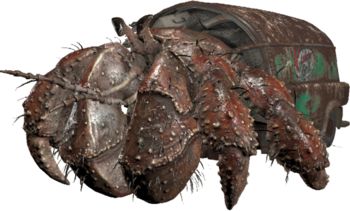
Gigantic hermit crabs who nest inside vehicles, generally found in swampy and highly irradiated areas.
- Ambushing Enemy: They hide inside wrecked trucks indistinguishable from regular scenery, until you get close and the crab pops out to attack.
- Foreshadowing: Sometimes, you'll find tire tracks or grounded up pavement leading to a wrecked vehicle. Given that no one in Far Harbor, let alone the east coast, has a functioning car or know how to salvage one, that means something must've dragged it around. Sure enough, investigating the wreck can introduce you to a giant hungry crab inside.
- Giant Enemy Crab: Giant hermit crabs grown to the size of trucks.
- Jump Scare: They like to wait until you get really close before popping out of their 'shell' to attack, which is particularly nerve wracking because Far Harbor has tons of other trucks that look like the ones hermit crabs will settle into, but will be empty, meaning it's hard to know which ones have a giant crab in it and which ones are hollowed out.
- Mighty Glacier: They very strong and have excellent defenses, but are slow, clumsy and poorly suited to chasing enemies. This is emphasized in elite variants, which become stronger and tougher but even slower.
- Unique Enemy: Downplayed in Far Harbor. There are several hanging around the Isle, but there's a set number of them and they do not respawn when killed — consequently, there's only a finite number you can encounter, after which there won't be any more. The only way for more of them to spawn is if a settler randomly gives you a radiant quest to hunt one.
- Visual Pun: They nest inside wrecked "Lobster Grill Family Restaurant" trucks.
- Weaksauce Weakness: Unlike almost every other mutated creature, they have zero tolerance towards radiation damage, so gamma guns, radium rifles and legendary weapons with the "Irradiated" property are surprisingly effective against them.
- Weaponized Offspring: They can attack distant players by spitting their own offspring at them.
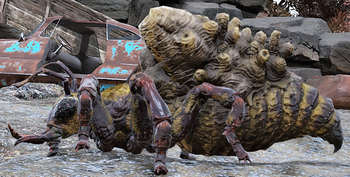
Giant, mutated and flightless queen bees found in post-War Appalachia, honey beasts carry their nests on their abdomen and wander in search of food. If threatened, the queen can easily attack back with their deadly mandibles and rush prey down while receiving support for their worker bees emerging from the nest to attack.
- Bee Afraid: Be very afraid of giant queen bees with mandibles large enough to split a person in half.
- Big Creepy-Crawlies: Honey beasts are roughly the size of a car, and they've got the temper to run people over just as well as one.
- Body Horror: Likely owing to being merely 25 years after the nuclear exchange, honey beasts have their giant nests jutting out of their bodies like a cancer tumor with plenty of exits for the worker drones. With how heavy and vulnerable the queen is, it might not out of the question to believe that they've gone extinct through natural selection as the new post-war ecosystem settled in, or are only able to thrive in the Appalachia's environment.
- Odd Friendship: Curiously, bloatflies and honey beasts get along well and will help each other in a fight.
- Zerg Rush: Anger the queen, and her swarm of bees will join the fight as well.

Giant praying mantis found in the Mojave Wasteland, giant mantis are the result of experimentation in Vault 22, which also happened to have been testing new pesticides. On top of its inhabitants being wiped out by their own pest control, these insects also escaped out of the Vault and established themselves as another predator to be encountered in the wastes.
- Ass Kicking Pose: Actually their idle animation, where a mantis will pose their forelimbs in the air and spread their vibrant wings if they're not hunting.
- Big Creepy-Crawlies: Like most Fallout insects, they're pretty huge and can easily prey on humans given the chance.
- Everyone Has Standards: Strangely for a Wasteland predator, Mojave mantis aren't too fond of trying to eat Ghouls and left Dr. Kelly alone despite having her at their mercy inside their cave. Could be a case of Shown Their Work, as real life mantis prefer their prey fresh and usually alive.
- Glass Cannon: Their damaging claws and love for lunging at their prey is offset by their fragile frame, a good attack from most weapons can bring them down.
- Slaying Mantis: Their hunting instinct's as good as their Pre-War's relative, only now basically any living thing's on the menu for them.

Massive sloths that are basically the Megatherium brought back from extinction thanks to radiation, and are now found throughout post-War Appalachia.
- Fog of Doom: Poisonous mushrooms grow in the algae on their back fur and become a deadly fog of spores in combat.
- Gentle Giant: Downplayed; they're still very dangerous animals and are far more aggressive than real-world sloths, but they mostly like to be left alone and won't go out of their way to attack people.
- Giant Mook: They stand well over nine feet tall.
- Historical In-Joke: Their presence in 76 is likely an allusion to how a giant ground sloth (specifically Megalonyx) is the state fossil of West Virgina, the game's primary setting.
- Lightning Bruiser: They're surprisingly quick at dodging attacks in combat.
- Misplaced Wildlife: Justified, as they were originally exotic pets of a local rich kid and escaped into the wild after the Great War.
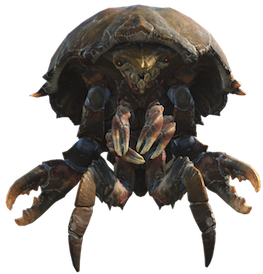
Rather than being a single type of creatures, the Mirelurks are a complex of multiple mutated animal species — chiefly horseshoe crabs, Atlantic blue crabs, lobsters and snapping turtles — living in a complex symbiotic lifestyle. They are native to the East Coast, rarely appearing further west than the Appalachians, and are usually found near bodies of water, such as swamps, rivers, sewage systems and the sea.
The mirelurks have the dubious honor of being one of the earliest strains of mutant animals to emerge, likely tracing their origins to abnormally large crabs and lobsters that emerged in the western Atlantic as a result of careless pollution by megacorporations and the apathetic US government.
- Acid Attack: In 4, the Mirelurk Hunters gain the ability to spew this from their mouths, which they do liberally. Mirelurk Queens have an even bigger, stronger version that can melt most humanoid enemies into piles of goo in only a few hits.
- Art Evolution:
- The basic 'lurks are one of the most extreme cases in the franchise: early, Fallout 3 and New Vegas Mirelurks are humanoid, upright and four-limbed bipeds with arms tipped with large claws and bulky, triangular Cephalothoraxes and very human-like legs. Fallout 4 and later mirelurk designs look like straight-up crustaceans that happen to stand more erect than usual, with a greater number of limbs and nothing like a human body structure.
- Mirelurk hunters started out in 3 as simply spiky, dark brown, more intimidating versions of the standard mirelurk. In 4, they’ve turned into giant mutant lobsters, an entirely different species from their horseshoe crab kin. They do have a spiritual successor in the form of the killclaw though, an upgraded version of the standard mirelurk who looks a lot like the former hunter variant.
- The mirelurk kings started out as fairly humanoid Fish People, but Fallout 4 reimagined them as much more bestial creatures with a more hunched-over posture, large and showy fins, more pronounced muzzles and larger and more visible tails.
- Attack Its Weak Point: For the crab variants, you need to attack them from the front and especially their face to deal damage. Hit them in the shell from behind, and you might as well have just thrown a rock at them.
- Attack of the 50-Foot Whatever: Mirelurk queens are utterly massive, about the size of a two-story building.
- Dig Attack: They're not as adept at it like radscorpions and mole rats in 4, but oftentimes you'll encounter mirelurks lying in wait beneath the sand or huge piles of trash. Get too close to where they're hiding and they'll pop right out to give chase.
- Fish People: Mirelurk Kings, despite being technically mutant turtles, have always looked more like humanoid fish than anything else. They have gills and rayed fins, among other things.
- Giant Enemy Crab: The bulk of the mirelurk variants are based on either horseshoe crabs or spiny lobsters that grow to be anywhere from the size of a dog to the size of a semi.
- Insect Queen: Despite being crustaceans, the enormous mirelurk queens fit most points of this trope. They appear to be where most horseshoe crab-type 'lurks come from, even being able to quickly eject barrages of hatchlings as a weapon and distraction, and are easily the largest and toughest members of the mirelurk species complex.
- Kryptonite Factor: Fallout 3's Broken Steel DLC reveals that mirelurks are so accustomed to irradiated and contaminated water that being submerged in purified fresh water actually weakens them, which is exactly what happened to the mirelurks in the Jefferson Memorial after Project Purity is activated.
- Lightning Bruiser:
- Mirelurk hunters in 4 are faster than the regular mirelurks, can hit even harder, and their shell protect their entire body unlike the regular mirelurks who are heavily armored from the back but weak from the front. Also unlike the other mirelurks, they don't have any obvious weak spots to exploit other than crippling their legs to slow them down.
- Mirelurk kings are the fastest variant, and while they don't have shells of any kind, they rely instead on pure muscle and endurance to fight past gunfire to maul their prey.
- Make Me Wanna Shout: Mirelurk kings can shout a mesmetron-like attack at their prey to hit them from a distance.
- Mix-and-Match Critters: The crab-based mirelurks appear to be this at a genetic level — an Enclave terminal in 3 contains research data which notes that their genome contains distinctive markers of both horseshoe and Atlantic blue crabs, suggesting that these distinct species were somehow hybridized or converged into one another to produce modern mirelurks.
- Mixed Animal Species Team: "Mirelurks" refers to an entire caste system of aquatic animal species who live in a symbiotic relationship. Horseshoe crabs (genetically mixed with blue crabs for good measure), lobsters, and mutant turtles make up the relationship, though how or why exactly these animals got together isn't really clear. The crab variants make the bulk of the system, serving as the main defenders of their territory with a gigantic queen responsible for breeding more numbers, the hunters/lobsters are implied to be tasked with hunting for food, and the king/turtle variants are implied to be in some kind of controlling position, using their greater intelligence to direct the other mirelurks in defending their territory and gathering food.
- Power Pincers: Their claws can easily cripple limbs, a danger that becomes apparent if you’re playing in survival mode.
- Red and Black and Evil All Over: Bloodrage mirelurks, the strongest of the base mirelurk types, have a unique black coloration with red eyes and accents. The powerful mirelurk kings also fit this aesthetic in 4.
- Underground Monkey: Like most other enemies, mirelurks come in a lot of types with their own tricks and quirks.
- The horseshoe crab variants include the standard mirelurks, weaker softshell mirelurks, the highly irradiated glowing mirelurks and nukalurks that deal radiation damage, and the powerful bloodrage mirelurks.
- The lobster variants include the basic mirelurk hunters, glowing mirelurk hunters and nukalurk hunters and powerful albino hunters.
- The kings include their own nuka- and glowing versions, in addition to stronger lakelurks from New Vegas and deep kings in 4 and 76.
- Weaponized Offspring: Mirelurk queens can shoot barrages of their own hatchlings at foes.

Large rodents engineered by the U.S. government before the Great War to be a disrupting agent in enemy territory and further mutated by fallout, mole rats are a common sight in the Wasteland. In the 2D games, they were very mole-like in appearance, but those in the later games are clearly naked mole rats.
- Action Bomb: One variety in both 4 and 76 comes with bombs strapped to its back. Their main means of attack consists of simply running at you and detonating. Even on a high-level character with good armor, this typically results in a One-Hit Kill.
- Art Evolution: They're significantly skinnier and smaller in 4 and 76 compared to their appearances in the previous two games.
- Attack Animal: In Appalachia, many of the local mole rats have been domesticated by the mole miners and assist them in combat.
- Bioweapon Beast: A subtle example, as they were engineered by the U.S government to serve as invasive pests.
- Dig Attack: In 4, they gain the ability to rapidly tunnel underground and pop up where they please, making them difficult to keep track of.
- The Goomba: They're some of the weakest and most common enemies in the games. They may be a threat early on, but it won't take too long until a blow or two from any common weapon will be enough to do even their strongest variants in.
- Genetic Engineering Is the New Nuke: According to some sources, the U.S. government created the mole rats as the ultimate invasive pests to be planted in enemy territory. They escaped into the wild after the War, and the traits bred into them for this purpose — high adaptability, rapid breeding rates, chiefly subterranean living habits and increased aggression — allowed them to survive and thrive in the wasteland.
- Maximum HP Reduction: The Vault 81 mole rats in 4 will, on attacking, infect you with their disease, permanently shaving 10 HP off your total unless you use the cure.
- Nested Mouths: It's not very visible, but the mole rat model in Fallout 4 has a second set of disturbingly human-looking teeth
 ◊ hidden behind its rodent-like incisors. This is Truth in Television: naked mole rats use their teeth to burrow, so they evolved incisors outside their lips so that digging doesn't completely suck.
◊ hidden behind its rodent-like incisors. This is Truth in Television: naked mole rats use their teeth to burrow, so they evolved incisors outside their lips so that digging doesn't completely suck. - Progressively Prettier: Inverted; They're downright adorable in 3 and New Vegas, but look like the hideous radioactive mutants they actually are in 4 and 76.
- Rodents of Unusual Size: Depending on the variety, they can be anywhere from the size of a cat to the size of a dog. Fallout 3 was also planned to include mole rats the size of buses that were used as transport animals,
 but they were cut from the game in the concept stage.
but they were cut from the game in the concept stage. - Took a Level in Badass: They're far more dangerous in Fallout 4 and 76 than they were in previous games since they now attack in packs and can tunnel under the earth to catch the player unawares.
- Wormsign: When they're tunneling around in a fight, their movement is marked by a faint outline of their tunnel.
- Zerg Rush: They're not terribly impressive enemies on their own, but a group can be an issue, especially since their burrowing abilities make them hard to keep track of — and they almost always come in groups.

The result of dogs being exposed/experimented on by FEV. First appearing in Appalachia and the Commonwealth, and can be always found accompanying their Super Mutant masters into battle.
- Admiring the Abomination: Like with centaurs, most Super Mutants think of Mutant Hounds like how we'd think of a loyal dog, caring for them like pets. Erickson in Far Harbor can even potentially sell tamed Mutant Hounds to the Sole Survivor to help with defending local settlements on Mount Desert Island.
- Attack Animal: They work alongside Super Mutants in battle, often howling to warn of intruders before charging forward and biting at the enemy.
- Beware of Vicious Dog: They're vicious, ill-tempered beasts that have been trained by their masters to maul anything in their path.
- Body Horror: Their bodies are heavily over-muscled and hairless, their skin is a discolored yellowish-green, their heads are severely oversized, and their teeth are so big that their mouths can't fully close.
- Bully Bulldog: According to Word of God, the vast majority of mutant hounds were formerly pitbulls.
- Canis Major: They're roughly three feet tall at the shoulder and about five feet along from snout to tail.
- Hell Is That Noise: Likely due to Rule of Scary, but for whatever reason, the howl of a Mutant Hound sounds more like a war horn than anything even remotely resembling a normal dog's howl.
- Sickly Green Glow: Some Mutant Hounds have been ghoulified by radiation poisoning and pulse with an ugly green light.
- Maximum HP Reduction: Their bites inflict radiation damage, lowering the Player Character's maximum health.
- Suspiciously Similar Substitute: To centaurs from earlier games. They fulfill a similar role as mutant creatures kept by Super Mutants as Attack Animals and pets, along with also being the result of FEV experimentation.
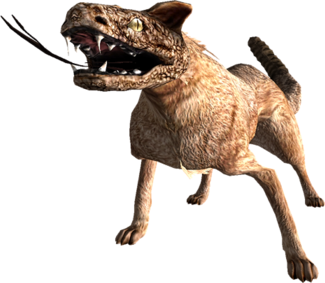
A genetic splicing of rattlesnake and coyote DNA, Nightstalkers are found in packs across the Mojave Wasteland. They're a deadly force for wandering Wastelanders thanks to their pack hunting nature and dangerous venom, overwhelming prey from multiple angles to bring them down.
- Artistic License – Biology: Real coyotes and rattlesnakes give live birth note . Despite this Nightstalkers in the game lay eggs. It's not clear if they nurse their young.
- Bioweapon Beast: They were artificially created by Dr. Borous, one of the researchers at the Big MT scientific facility, largely for the hell of it. They were supposed to be sterile, but naturally enough they weren't and spread like wildfire after the nuclear war.
- Boss Battle: The Legendary Nightstalker, found in the Bloodborne Cave. Like all Legendary animals it's overwhelmingly strong, but this nightstalker is also the most fragile of the roster.
- Damage Over Time: Like the cazadores, they favor killing their prey with venom overtime, although theirs isn't as fatal as cazador venom. Also like the cazadores, fighting a pack of nightstalkers unprepared will probably get you killed long before the venom can take you out.
- Mix-and-Match Critters: Dr. Borous of Big MT couldn't remember whether he created these things to save rattlesnake DNA, or because someone dared him to, but either way he ended up breeding these strange creatures to have the bodies of coyotes and the heads and tails of rattlesnakes. Vocally, they will also bark and whimper like coyotes and let out warning rattles and hiss like rattlesnakes.
- The Rival: To the cazador population in Big MT, as they were both made in the same research facility. Long after breaking containment, these animals are competing for territory in the labs. Out in the Mojave, though, it's not as pronounced.
- Western Rattlers: The part-rattlesnake nightstalkers are one of the emblematic monsters of New Vegas, which is set in the Mojave Desert and effectively the series' Cowboy Episode.

Cockroaches that mutated to huge sizes thanks to the radiation from the bombs. They're generally very weak and are usually the first enemy that the player fights, but tend to appear in groups.
- Big Creepy-Crawlies: They're cockroaches the size of a cat.
- Cockroaches Will Rule the Earth: Averted, despite how much the games draw on classic post-apocalyptic tropes; they survived and grew larger alright, but they're at the bottom of the food chain.
- Creepy Cockroach: They're not a threat, even to level 1 players, but they're associated with decay and several characters in Fallout 3 and Fallout 4 react to them with disgust and horror.
- The Goomba: The weakest enemies in the entire series. They almost always takes a single hit from most weapons — or even a single physical blow — to die, and deal pathetic damage to the player.
- Iconic Sequel Character: They only started showing up in the Bethesda era games, but they fit into the world so well that its hard to imagine the franchise without them.
- Maximum HP Reduction: In 4, their attacks deal radiation damage to the player, which lowers max HP.
- No-Sell: They're immune to radiation attacks.
- Normal Fish in a Tiny Pond: They are quite low down in the pecking order of wasteland creatures, but they can squeeze into areas considered airtight. This makes them rather dangerous to certain cloistered wasteland communities where people don't carry weapons at all times, such as Vaults.
- One-Hit-Point Wonder: Not really 1 HP, but even the weakest attack from a melee weapon usually offs them quickly.
- Square-Cube Law: They cannot fly, and an Enclave research log in 3 notes that this is likely due to how, because of them simply being upscaled roaches, their wing musculature simply isn't able to lift their increased body mass.
- Unusual Pets for Unusual People: An abandoned sniper shack in the Capital Wasteland has two caged Radroaches named "Fluffy" and "Jitters" kept as pets.
- Zerg Rush: Expect to find more of them when you see one. Either way, they're a minor nuisance.

Enormous scorpions descended from mutated emperor scorpions kept as pets before the Great War, radscorpions have been grown to massive sizes by exposure to nuclear fallout, and have thrived and spread throughout the wastelands of North America in the centuries since the war.
- Animal Jingoism: There are two variants of giant scorpions living in the Mojave Wasteland: true radscorpions and the smaller bark scorpions, mutated versions of the common North American striped bark scorpion. The two species do not get along, and radscorpions often prey on their smaller cousins.
- Ascended Glitch: In 3 and New Vegas, Radscorpions would sometimes glitch underneath the ground, and would fall through when you got close to them. In 4, Radscorpions are one of only two enemies (the other being Mole Rats) that gain this ability as an attack, being coded to burrow and move underground as a standard action.
- Big Creepy-Crawlies: Their ancestors, while big as scorpions went, were nothing too unreasonably large by real life standards. Radiation-induced mutation, however, has turned them even bigger than the other giant arthropods in the wastes: the smallest are easily as big as a large person, and the largest are bigger than a car.
- Boss in Mook Clothing: 3's Broken Steel DLC introduced Albino Radscorpions, every bit as big and fast as regular giant radscorpions, but harder to see from a distance, with much higher damage potential, and durable enough to take a nuke on the chin and keep on going as if nothing happened (and this is not an exaggeration), regenerating all the while.
- Dig Attack: In 4, they gain the ability to tunnel underground and move extremely quickly while doing so, making fleeing from them extremely difficult.
- Finishing Move: On low health players, they can use their stinger to impale them right in the chest and raise the corpse up in the air before shaking them loose.
- Jump Scare: In 4 where they have the ability to burrow. Unlike the small radroaches and mole rats, and the mirelurks who have a reasonably far distance to get alerted from, radscorpions love to wait until you're right on top of them before they jump from their hiding spot. Often times, you'll find a valuable looking dead body or container to loot from only to approach it and have an angry radscorpion spawn right in your face.
- Misplaced Wildlife: Justified. While Emperor Scorpions are endemic to West Africa, they were popular pets in America before the Great War. When the bombs dropped, they spread across the continent.
- Poisonous Person: Their chief offensive weapons are their highly venomous stingers. You can harvest their poison glands to create a variety of poisons for your own use, as well as antivenin medicines.
- Scary Scorpions: When scorpions are at minimum the size of a large person, highly venomous, and horribly aggressive, they're very scary indeed.
- Skeleton Motif: Deathskull radscorpions, the most dangerous and powerful variant of radscorpions in Fallout 4, are distinguished by a white, skull-shaped mark around their eyes.
- Took a Level in Badass: They get elevated from being Goddamned Bats in Fallout: New Vegas to outright Demonic Spiders in Fallout 4 thanks to their significant increase in size, larger health pools, stronger armor, deadlier poison damage, and ability to tunnel below the ground to avoid attacks and catch others unawares.
- Underground Monkey: Like most other Fallout enemies, they have their share of variants, including giant and albino radscorpions with higher health and attack, bark scorpions with more potent venom, and, in 4, glowing radscorpions that deal radiation damage and rare and powerful deathskull radscorpions.
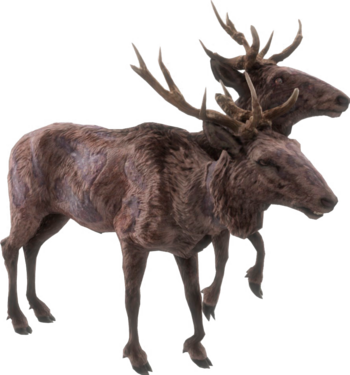
Radstags are mutated deer who, after the Great War, have developed an assortment of strange and dramatic mutations across their bodies, the most obviously being their second living head. They're found mostly on the East Coast and Appalachia, and are prized as valuable prey animals by post-War hunters.
- Ascended to Carnivorism: "Devolved" radstags can be found on Mount Desert Island in the Far Harbor DLC for Fallout 4. Unlike their mainland counterparts, these carnivorous radstags have sharp fangs and will actively search out for prey (read: you).
- Body Horror: The radstags' mutations, unfortunately for them, match the debilitating effects of real-life mutagens a lot more closely than usual for Fallout animals. They have two useless, malformed vestigial legs dangling from the front of their chests, along with areas of hairless, inflamed flesh and numerous cysts leaking pus found in their patchy fur. The devolved radstags have it even worse, with what looks like gaping holes in their flanks, cracked leathery skin, and heavily twisted horns.
- Dirty Coward: The loading screen hints for Fallout 4 outright describes a radstag as "a pathetic creature that will likely run at the first sign of contact".
- Finishing Move: If forced to fight back, radstags with antlers will charge the player to the ground, grind them up with their antlers and headbutt them a couple feet ahead.
- Fragile Speedster: They don't have that much health and don't deal that much damage either, but are incredibly fast and so actually hitting one will likely be the toughest challenge one will face if they ever want/need to kill a Radstag.
- The Goomba: They're among the weakest of the series' Wasteland mutants, though they can prove to be actually dangerous to underleveled players if they're backed into a corner.
- Impaled with Extreme Prejudice: If sufficiently threatened, they can kill the Player Character by skewering them on their horns.
- The Marvelous Deer: In a quest in Far Harbor, you confront Brother Devin, a member of the Children of Atom who is killing himself in an extreme religious fast. He claims to have found his faith when, while indulging his drug habit in the woods one day, a "verdant stag, wreathed in holy Glow" (i.e. a glowing radstag) strode out of the sky and commanded him to give up his iniquities and devote himself to Atom.
- Non-Indicative Name: "Radstag" is used a generic term for the entire species, despite it strictly referring to male deer in real life — females are called "radstag does".
- Screw This, I'm Outta Here: Like the deer that they're descended from, their primary strategy whenever spotted by any threat is to run like Hell in the opposite direction.
- Vertebrate with Extra Limbs: Mutation gave them another pair of legs between and in front of their old front pair, although they're small, malformed and hang uselessly a good couple feet above the ground.

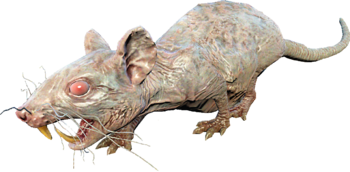
Referred to alternatively as giant rats, radrats or simply rats, multiple strains of mutated murines can be found throughout the wastes of North America.
- Body Horror: Certain varieties in 4 and 76 have large patches on their bodies where their skin is simply missing, covering them in ugly, bleeding lesions.
- Cowardly Mooks: Giant rat pups in New Vegas will flee from players on sight, and will only attack if stronger specimens are around. Justified as, in-universe, they're still juveniles.
- The Goomba: While the largest ones can provide a decent threat even in the late game, the vast majority of these guys are small, weak and pretty pathetic, and only menace even novice players when in groups. The ones in 76 are even among the particularly weak enemies intended to serve as a source of food more than as actual threats.
- Rodents of Unusual Size: Depending on the specific breed and individual, they can reach anywhere from the size of a cat to the size of a grown human being.
- You Dirty Rat!: Viciously aggressive mutant rats found swarming through the ruins of civilization.
- Zerg Rush: The smaller varieties are usually fairly weak, but are often found in large groups and can overwhelm players through numbers, attrition and multidirectional attacks.
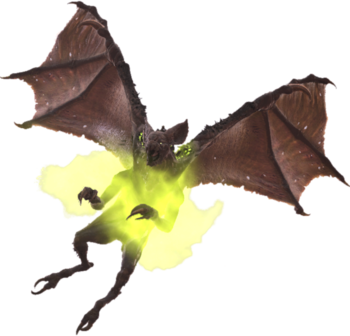
The result of the Appalachian Enclave's biochemical experiments on irradiated bats after the Great War, scorchbeasts are terrifyingly massive and dangerous beasts who are responsible for the spread of the "Scorched Plague", a devastating virus that converts all life it comes into contact with into a Hive Mind of feral and cannibalistic monsters.
- Attack of the 50-Foot Whatever: Scorchbeasts have the wingspan of small planes.
- Bat Out of Hell: Scorchbeasts are an extreme version of this, being truck-sized, monstrously aggressive, plague-spreading bats that drove all surviving civilization in Appalachia to extinction.
- Beneath the Earth: They live primarily below ground, sometimes clawing to the surface in devastating "fissure events" that require the resultant rifts to be nuked in order to prevent the spread of the Scorched Plague.
- Big Bad: The Scorchbeasts as a whole are this for Fallout: 76, with the game's main plot being dedicated to driving them to extinction so as to prevent them from spreading to the outside world.
- Civilization Destroyer: They — and specifically the plague they spread — are the reason why there is no surviving civilization in Appalachia at the start of 76.
- The Dreaded: All surviving records across Appalachia describe these creatures with utter terror and awe, and it's for a damn good reason.
- Fog of Doom: Scorchbeasts can summon clouds of radioactive fog around themselves when in combat.
- From Nobody to Nightmare: The scorchbeasts descend from mundane bats turned into monsters by the Enclave's experiments.
- Make Me Wanna Shout: The scorchbeasts' primary attack is to unleash an ear-splitting sonic scream from their mouths.
- Mook Maker: By virtue of spreading the Scorched Plague, scorchbeasts can convert other forms of life to their aid and use them in battle.
- Nigh-Invulnerable: The scorchbeasts are so ridiculously tough that it takes point-blank nuclear strikes to destroy their nests and leave them open to being killed.
- Our Dragons Are Different: They're the closest thing that a retro-futurisitic Speculative Fiction setting like Fallout can get to actual Western dragons without diving outright into Science Fantasy, what with them being huge, four-legged flying monsters with a devastating Breath Weapon that desire nothing more than to destroy everything in their path.
- Plaguemaster: Their main threat (as if being giant mutated Nigh-Invulnerable bats wasn't enough) is that they're the primary vector for the Scorched Plague, which mutates any lifeform it comes into contact with into a monstrous, crystal-covered pseudo-zombie that attacks all life that isn't infected by the plague.
- Unwitting Pawn: Of the Appalachian Enclave, who were trying to use them so as to artificially raise the DEFCON level to justify another nuclear strike against China on the orders of the profoundly delusional Secretary Eckhart.
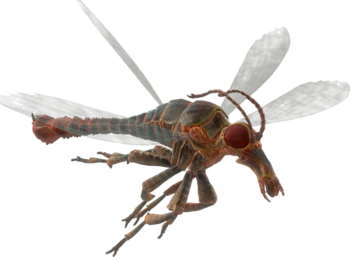
Some of the fastest most aggressive insects found in the Commonwealth, Stingwings make their nests across the Wasteland and emerge to defend them in small swarms, delivering venomous stings while making sure their prey can't flee.
- Animal Gender-Bender: In scorpionflies, only the males have the long tail that looks like a stinger, as it's actually a set of claspers used for mating. Stingwings in Fallout have apparently evolved to make these tails universal within the species.
- Big Creepy-Crawlies: Stingwings are a fair sight larger than real scorpionflies, reaching the dimensions of a good-sized bird of prey.
- Fragile Speedster: Stingwings are fast and can hit hard, but their small size means that you can blow them away reliably once they're in your crosshairs.
- Suspiciously Similar Substitute: They're fast, flying, venomous, swarm-attacking and highly dangerous predators among insects. In other words, they're the East Coast equivalent of cazadores.

Weird... creatures that infest the Great Wanamingo Mine in Redding. Some can also be found roaming around Northern California and in the lower decks of the PMV Valdez in San Francisco. They're also called "aliens" by the Wasteland at large, but are actually a pre-war creation of the USA to serve as shock troopers, similar to Deathclaws.
- Bioweapon Beast: They were created in a lab by American scientists, but in the aftermath of the Great War they got loose in New California.
- Cowardly Mooks: While vicious in battle, should one of their limbs be crippled, they become utterly harmless and only flee, never attacking again.
- Dying Race: It's mentioned in the Fallout Bibles that they go extinct five years after the events of Fallout 2 due to some kind of built-in "genetic clock", which isn't elaborated much upon, but was likely built into them by the pre-war USA as a means of population control. Plus, they can only reproduce through a queen, and the Chosen One shoots the only (known) one.
- Hive Queen: She lays eggs and acts as the boss of the Great Wanamingo Mine.
- Kill It with Fire: Low DT against fire, yay!
- Made of Iron: They have fairly high resistances to most damage types, except fire.
- Super-Toughness: The regular Wanamingos are no joke, but the "tough" variants and the queen have a DT of 12 for normal damage, the equivalent of regular T-51b Power Armor.
- Starfish Aliens: They're not really aliens, but they're certainly incredibly weird, and don't look like any natural animal. Even the game interface is confused. When you take aimed shots at them their body parts like are labelled with question marks. If they're shot in the "eyes", the dialogue box will say their "air intake (?) was damaged".
- Xenomorph Xerox: Their head and mouths make them look like xenomorphs. Plus they're led by a queen that lays eggs. They're also weak to fire, encouraging you to dispatch them with a flamethrower. Plus their lair is covered in biological goo, probably secreted by them, just like the alien hives. It may or may not be a coincidence, but there's also an utility elevator leading right into their queen's nest, complete with eggs, just like in the climax of Aliens.

Native to Far Harbor, the core design of wolves hasn't changed very much in post-war America, bearing only a larger set of teeth and claws with a leaner build. What has changed however is their boldness and ferocity, wasting no time in surrounding their prey from multiple angles to bring down the force of the pack on them.
- Angry Guard Dog: You can buy tamed wolves from Erickson to act as guard dogs for your settlements.
- Fragile Speedster: Compared to the fast and sturdy fog crawlers and gulpers, and the slower but deadly anglers and yao guai, wolves stand out as these on the island. Even their toughest variants won't need as much effort to kill as the other mutant animals.
- Law of Chromatic Superiority: Black wolves are the weakest of the packs, while the pale white variants tend to be tougher, only outdone by rabid wolves who have brown coats.
- Savage Wolves: While real-life wolf attacks are generally rare, Far Harbor wolves will charge and surround humans on sight.
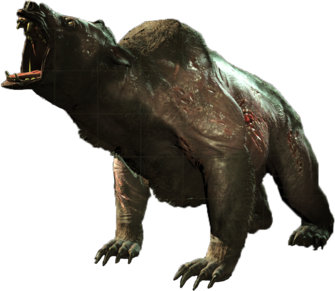
Mutated from the black bears that populated America before the Great War, yao guai live up to their species' legacy as some of the most powerful land predators to walk the Earth, just short of being apex predators thanks to being outdone by the deathclaws. Due to their decayed and undead-like physique, it's possible that yao guai are the bear equivalent of ghouls.
- Adaptational Wimp: Downplayed in the live-action series. A Yao Guai manhandles a Brotherhood of Steel knight in power armor, which fits their destructive power, but falls to two headshots from a small pistol, when it would usually take much more to kill them in the games.
- Art Evolution: The yao guai go through a rather significant shift in appearance between New Vegas and 4. In the earlier games, they're much more deformed, with scabrous, greenish skin, narrow muzzles and arms much longer than their legs. In and after 4 they're much more ursine, retaining the body and facial proportions of bears and have more subdued skin colors (to the point where their fur color is now closer to purple than to green).
- Bears Are Bad News: They're oversized, ravenous and eager to attack and kill anything for a meal. They're about some of the worst things you can bump into in the wild. Notably, their species of origin, black bears, is by far the smallest, shiest and least aggressive of the two bear species in North America.
- Beary Friendly. Not by default, but take the Animal Friend perk in 3 and they'll be pacified by your presence and leave you be, or even come to help protect you if you're in trouble near them with the second rank of the perk. It doesn't work at all in ''New Vegas'' though, and in 4 it's a coin flip if you try to pacify them.
- In Fallout 3 it's possible to find roving scavengers who keep tamed yao guai as pets for companionship and protection.
- Body Horror: Their hides usually look mangy, spotty and covered in sores.
- Boss Battle: The Ghost of She, a giant flaming yao guai ghost that the Courier is sent to kill as part of a trial. Well, it might be a flaming ghost and might not be, given that the Courier was high and hallucinating off of tribal herbal tea at the time.
- The Bus Came Back: After being absent in the base version of New Vegas, the yao guai came back with a vengeance in the Honest Hearts DLC. They're absurdly powerful and sturdy, and they can easily grow to sizes that eclipse the player. Bumping into one without preparation can lead to a swift death.
- Establishing Character Moment: A brief one in Honest Hearts, where shortly into your trek into the canyons you can spy a giant yao guai maul a giant gecko and take off, warning the player that the yao guai are back and bigger than ever.
- Finishing Move: When killing injured humans in 4, they can throw their entire weight on their prey and pin them down while they take a huge bite from the victim's throat.
- From Nobody to Nightmare: Real life black bears are relatively small Shrinking Violets who are very likely to run away if you yell at them too hard. In Fallout they're a major hazard with few other threats being worse.
- Lightning Bruiser: They're not the fastest in the Wastes, but they're fast enough to keep up with a human and maul them to death if they aren't gunned down in time.
- Mini Mook: Stunted yao guai in 4, which are smaller and weaker versions of the standard yao guai. Whether they're juveniles or are suffering from a growth defect isn't clear, but they're typically encountered in the lower levels of the player's playthrough as an introduction to yao guai before the real deal shows up.
- Names to Run Away from Really Fast: In Mandarin Chinese, "yaoguai" translates to "demon" or "monster". Given their reputation, they've earned that title.
- Wreathed in Flames: In the Honest Hearts DLC for New Vegas, you can fight a possibly hallucinatory yao guai wreathed in fire called the "Ghost of She".
Cryptids

A large, bluish dog-like creature with a terrifying howl.
- Beastly Bloodsports: According to the research Clyde conducted for Aries, the unknown animal species the Blue Devil mutated from used to be bred for racing and then fighting before and even after the Great War.
- Supernatural Fear Inducer: Its howl attack can induce Uncontrollable Fear in the Resident, much like the scream attack of a wendigo colossus.

A Zetan alien that kidnaps fauna for experimentation. It can be very rarely found around the map, but mostly near Flatwoods.
- Cyborg: Implied. In addition to a unique "bubble" helmet that connects via a tube to a chest-mounted breathing apparatus, the Flatwoods Monster has no legs, instead trailing off into a conical-shaped mass of metal that mounts small jump jets, allowing it to hover. It could just be an unusual form of Powered Armor, however.
- The Dreaded: Stories about it persist throughout West Virginia, and did so even before the nukes dropped.
- The Flatwoods Monster: The Fallout universe version of it. Though in truth there are way more Zetans than just this guy.
- "Get Back Here!" Boss: It will turn tail at the first sign of danger by teleporting away. You'll need to ambush it to kill it.
- Mind Manipulation: Capable of mind control.
- Telepathic Spacemen: Its main defense is to control the minds of nearby creatures and people into attacking you.

A massive, grotesque being that resulted from Forced Evolutionary Virus experiments conducted at West Tek.
- Body Horror: You can't even tell that this thing used to be human anymore.
- Top-Heavy Guy: It needs to use it's massive arms to even move.
- Walking Wasteland: It spews out a toxic... substance, of some sort, which deals damage over time and is left in it's wake.

Perhaps the most famous cryptid in West Virginia, the Mothman is the fabled harbinger of disaster in Appalachian folklore. It is worshipped by cultists found here and there in Appalachia, who are headquartered in Point Pleasant. Troublingly, it seems as though the Mothman existed before the bombs dropped.
- Ambiguous Situation: Is it the real Mothman? Does it cause disasters, predict them, try to warn people of them, or are its appearances just unfortunate coincidences? Obviously it exists, since you can directly interact with it, but it's hard to separate fact from myth given its nature, and you can't have any dialogue with it to get any answers (though it does impart some "wisdom" onto you if you help it, but that only translates to an EXP boost). It does have a "nest" near the Mothman Museum, which explains the other hostile and scorched mothmen you can find around the map, but no explanation for the "main" one that stalks you is ever given.
- Big Creepy-Crawlies: A moth, naturally.
- By the Lights of Their Eyes: It stalks you around the map shortly after the game starts, and can only be spotted if you see it's glowing eyes in the distance (it doesn't appear on your compass).
- Jump Scare: The Mothman's primary method of relocation is leaping into the air and landing right in front of the player, which can provide this effect, especially if you were trying to snipe one with a scoped rifle before it did this.
- Maybe Magic, Maybe Mundane: The most logical explanation (well, logical by Fallout standards, anyhow) is that it's a moth mutated by the nuclear radiation, similar to the other large insects in the series. However, several documents related to the Cult of the Mothman seem to indicate it was around before the nuclear fallout. What's more, it even replicates the tendency to appear just before a catastrophe, just like the folklore version of it.
- The Mothman: The genuine article. Maybe.
- No Body Left Behind: If you kill it, it dissolves as it flails on the ground helplessly before finally collapsing, letting off some final, sporadic twitches of trying to fly again before disintegrating completely, leaving behind a pile of ash (and loot).
- Portent of Doom: Just like the real-world folklore version of it, Mothman's appearance usually signals an impending tragedy. In the context of Fallout, it appeared just before the bombs fell, and before Thorpe destroyed the dam. The fact that it appears before you is likely referencing your use of nukes in the main questline.
- Red Eyes, Take Warning: If the Mothman has red eyes, then it is intending to kill you. You should run. If it has yellow eyes, then it should still be taken dangerously. If it has purple or lavender eyes, relax. The Wise Mothman is very friendly and passive to players and can grant temporary boons to them, like bonus experience for a while.
- Stalker without a Crush: Shortly after you leave Vault 76, you may notice a pair of glowing eyes in the distance as you explore... If you try and move towards it, it will flee.

A large, turtle-like cryptid.
- Blood Magic: The Cult of the Mothman are attempting to capture and sacrifice the Ogua, as they believe it possesses "ancient" blood that holds divine secrets as well as the ability to see into the past.
- Shy Shelled Animal: Withdraws into its shell every so often during combat, rendering it immune to all damage while doing so. Attackers must wait for the Ogua to emerge from its shell again before they can damage it.

Massive mutated sheep, given extreme muscle density, sharp quills, and bipedal skeletal structure. How they came to be is unknown, and they existed even before the Great War. Unrelated to the Imposter Sheepsquach created by Calvin van Lowe/Aries.
- Ambiguous Situation: Unlike the Mothman, we have definite confirmation that the Sheepsquatch existed prior to the nuclear fallout; a picnic location in the Toxic Valley has a holotape recording of two pre-war teenagers being killed by one (further evidenced by the quills lodged in their bodies). But this only raises the question of where exactly these things came from in the first place.
- Our Minotaurs Are Different: It has the basic semblance of a minotaur, being a large Horned Humanoid based on a horned herd animal, but it's based on a sheep rather than a cow.
- Spike Shooter: If you think you can hide on a vantage point for refuge from these things, you're in for a prickly surprise when it crouches down or grabs some of its quills off its back.
- Turns Red: They're healed back to full and gain considerable damage buffs once they hit half health, due to all Sheepsquatches being Legendary enemies and thus are subjected to the same mutation mechanic. Quite literally as well, since mutated Sheepsquatches glow red.

Hideously deformed reptilian mutants produced by the FEV experiments at West-Tek before the War, the Snallygasters have thrived since the bombs dropped.
- Body Horror: You can't even tell that this thing used to be human anymore.
- Eyes Do Not Belong There: They have about forty eyes dotted all over their humped backs, but ironically they have an Eyeless Face.
- Super Spit: Attacks from afar by spitting acidic slime.
- Was Once a Man: Despite looking like some kind of twisted, six-legged reptile, they actually descend from human experiments, just like their companions, the Grafton Monsters.

Humans whose bodies have mutated in a truly disturbing fashion, with lean limbs, unhinged jaws, and distended bellies. Legends say this is the fate that awaits humans driven to cannibalism, their transformation a result of being possessed by a malevolent spirit. But that last part probably isn't true... right?
- Maybe Magic, Maybe Mundane: Like the Mothman, there's a reasonable explanation as to how these things exist within the context of Fallout, since human mutants such as ghouls exist. It's not very likely that nuclear radiation played a role in their transformation, since Earle Williams turned into one sometime around 2076, before any of the bombs fell. At the same time, it seems a little too convenient that every single wendigo was a cannibal as a human. Ghosts do exist in the Fallout universe, after all, so it doesn't seem like too much of a stretch.
- Recognizable by Sound: Wendigoes can more often than not be located based on their loud, raspy breathing that serves as a telltale sign that one is nearby.
- Sadly Mythtaken: Wendigo are not cryptids in real life, since their origin can be traced back to Native American folklore, but the game classifies wendigo as cryptids regardless for gameplay purposes.
- Super-Scream: Their signature attack is a loud scream that can disorient prey, allowing them to close the gap and get a few good swipes in.
- Wendigo: Exactly What It Says on the Tin. Of the "monstrous human" variety.
- Was Once a Man: Obviously, given the nature of wendigoes. There are also several unique individuals encountered in the game that are still referred to by their human names, such as camp counselor Nia, or Earle Williams.






